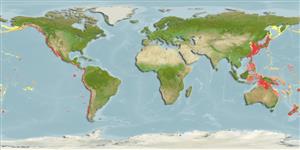分類 / Names
俗名 | 同種異名 | Catalog of Fishes(屬, 種) | ITIS | CoL | WoRMS | Cloffa
Teleostei >
Scombriformes (Mackerels)
鱸形目 (Mackerels) >
Scombridae (Mackerels, tunas, bonitos)
鯖科 (Mackerels, tunas, bonitos) > Scombrinae
Etymology: Scomber: Greek, skombros = tunny or mackerel, 1623 (Ref. 45335); japonicus: Named after Japan, its type locality (Ref. 6885).
Environment: milieu / climate zone / depth range / distribution range
生態學
海洋; 海洋洄游的 (Ref. 51243); 深度上下限 0 - 300 m (Ref. 168), usually 50 - 200 m (Ref. 35185). 亞熱帶的; 10°C - 27°C (Ref. 35185); 60°N - 48°S, 116°E - 70°W
Indo-Pacific: anti-tropical, absent from the Indian Ocean except for South Africa, KZN to Western Cape (58304).
Reports from Atlantic incl. Mediterranean are Scomber colias, and from Red Sea and northern Indian Ocean are Scomber australasicus (Ref. 27328).
Circumglobal ,美國東岸從加拿大新斯科舍省到阿根廷東部.(參考文獻 47377) 為鰷魚鯖 Scomber japonicus 的印度-太平洋的分布; Scomber colias 被發現於大西洋。 (參考文獻 33246) Scomber japonicus 是顯然地印尼與澳洲沒有出現而且被 Scomber australasicus 取代.(參考文獻 9684) 族群從紅海與印度洋北部 (亞丁灣與阿曼) 是 Scomber australasicus 。 (參考文獻 27328) 在樣本從大西洋與印度-太平洋的族群之中的 haplotypes 的完全的區分顯示出他們可能需要被鑑定為個別的種.(參考文獻 30232)
Length at first maturity / 大小 / 重量 / 年齡
Maturity: Lm 26.1 range ? - ? cm
Max length : 64.0 cm TL 雄魚/尚未辨別雌雄; (Ref. 9015); common length : 30.0 cm FL 雄魚/尚未辨別雌雄; (Ref. 168); 最大體重: 2.9 kg (Ref. 26550); 最大年齡: 18 年 (Ref. 35185)
背棘 (總數): 9 - 11; 背的軟條 (總數): 112; 臀棘 1; 臀鰭軟條: 12 - 14; 脊椎骨: 31. Interpelvic process small and single. No well developed corselet. Swim bladder present. First haemal spine posterior to first interneural process; 12 to 15 interneural bones under first dorsal fin. Anal fin spine conspicuous, clearly separated from anal rays but joined to them by a membrane. Back with narrow stripes which zigzag and undulate. Belly unmarked (Pacific population) or with wavy lines (Atlantic pop.) (Ref. 168). Caudal peduncle with 5 finlets on the upper and lower edge. Distance between dorsal fins shorter than or equal to the first dorsal fin base (Ref. 35388).
腹鰭間的突起小的與單個。 沒有發展良好的甲胄。 有泳鰾。 第一個脈棘第一個背側間的突起後面; 在第一背鰭下面的 12 到 15個背側間的硬骨。 臀鰭棘顯著的, 清楚地與臀鰭鰭條分開了但是連到了他們經由一個膜。 背面有狹窄的斑紋曲折而且波動。 腹面無標記的 (太平洋族群) 或與波浪狀的線 (大西洋的族群).(參考文獻 168) 在上、下邊緣上尾梗有 5個離鰭。 背鰭之間的距離短於或者等於第一背鰭基底.(參考文獻 35388)
A coastal pelagic species, to a lesser extent epipelagic to mesopelagic over the continental slope (Ref. 168). Schooling by size is well developed and initiates at approximately 3 cm (Ref. 168); may also form schools with Sarda chiliensis, Trachurus symmetricus and Sardinops sagax (Ref. 9340). Adults stay near the bottom during the day; go up to the open water at night, (Ref. 5377) where they feed on copepods and other crustaceans, fishes and squids (Ref. 168). They spawn in batches (Ref. 51846). Eggs and larvae are pelagic (Ref. 6769). In Asian waters, they move to deeper water and remain inactive during the winter season (Ref. 4576). Commercially cultured in Japan. Marketed fresh, frozen, smoked, salted and occasionally canned (Ref. 9684). Eaten fried, broiled and baked (Ref. 9988). Used in Chinese medicine (Ref. 12166).
一個海岸的大洋性魚種, 對在大陸斜坡上的一個較少的範圍表層帶到海洋中層帶的魚種.(參考文獻 168) 依大小形成魚群在大約 3 公分是發展良好的與新入會者;(參考文獻 168) 也可能與 Sarda chiliensis , 太平洋竹筴魚〔Trachurus symmetricus〕 與 Sardinops sagax 形成魚群。 (參考文獻 9340) 在白天期間的在底部附近的成魚停留; 去向上到開放水域在晚上 ,(參考文獻 5377) 在那裡它們吃橈腳類的動物與其他的甲殼動物,魚與烏賊.(參考文獻 168) 他們產卵於一批中。 (參考文獻 51846) 在亞洲水域,他們移動到較深的水域而且在冬季期間保持不活躍。 (參考文獻 4576) 商業地在日本養殖。 在市場上銷售生鮮地,凍結,煙燻, 鹽醃的而且偶然地裝於罐頭.(參考文獻 9684) 油炸後食用, 火烤.而且燒烤.。 (參考文獻 9988) 被用於中藥材.。 (參考文獻 12166)
Life cycle and mating behavior
成熟度 | 繁殖 | 產卵場 | 卵 | 孕卵數 | 仔魚
Spawning most often occurs at water temperatures of 15° to 20°C. Spawn in several batches with 250 to 300 eggs per g of fish with the total number of eggs per female ranging from 100,000 to 400,000.Circumglobal ,美國東岸從加拿大新斯科舍省到阿根廷東部.(參考文獻 47377) 為鰷魚鯖 Scomber japonicus 的印度-太平洋的分布; Scomber colias 被發現於大西洋。 (參考文獻 33246) Scomber japonicus 是顯然地印尼與澳洲沒有出現而且被 Scomber australasicus 取代.(參考文獻 9684) 族群從紅海與印度洋北部 (亞丁灣與阿曼) 是 Scomber australasicus 。 (參考文獻 27328) 在樣本從大西洋與印度-太平洋的族群之中的 haplotypes 的完全的區分顯示出他們可能需要被鑑定為個別的種.(參考文獻 30232)
Collette, B.B. and C.E. Nauen, 1983. FAO Species Catalogue. Vol. 2. Scombrids of the world. An annotated and illustrated catalogue of tunas, mackerels, bonitos and related species known to date. Rome: FAO. FAO Fish. Synop. 125(2):137 p. (Ref. 168)
人類使用
漁業: 高經濟性; 養殖: 商業性; 游釣魚種: 是的; 誘餌: usually
工具
特別的報告
下載 XML
網路資源
Estimates based on models
Preferred temperature (Ref.
123201): 9.3 - 27.7, mean 20.7 °C (based on 1526 cells).
Phylogenetic diversity index (Ref.
82804): PD
50 = 0.5625 [Uniqueness, from 0.5 = low to 2.0 = high].
Bayesian length-weight: a=0.00741 (0.00662 - 0.00830), b=3.05 (3.02 - 3.08), in cm total length, based on LWR estimates for this species (Ref.
93245).
營養階層 (Ref.
69278): 3.4 ±0.1 se; based on diet studies.
Generation time: 3.6 (3.1 - 5.0) years. Estimated as median ln(3)/K based on 24
growth studies.
回復力 (Ref.
120179): 中等的, 族群倍增時間最少 1.4 - 4.4年 (K=0.12-0.22; tm=2-3; tmax=18).
Prior r = 0.48, 95% CL = 0.32 - 0.73, Based on 3 stock assessments.
Fishing Vulnerability (Ref.
59153): Low to moderate vulnerability (31 of 100).
Climate Vulnerability (Ref.
125649): Low vulnerability (24 of 100).
Nutrients (Ref.
124155): Calcium = 48.8 [16.2, 118.3] mg/100g; Iron = 2.18 [0.83, 5.26] mg/100g; Protein = 20.9 [19.8, 21.8] %; Omega3 = 0.358 [0.247, 0.525] g/100g; Selenium = 98.1 [37.9, 229.9] μg/100g; VitaminA = 13.7 [3.5, 60.5] μg/100g; Zinc = 0.846 [0.514, 1.358] mg/100g (wet weight); based on
nutrient studies.
